The Intel Xeon W Review: W-2195, W-2155, W-2123, W-2104 and W-2102 Tested
by Ian Cutress & Joe Shields on July 30, 2018 1:00 PM EST- Posted in
- CPUs
- Intel
- Xeon
- Workstation
- ECC
- Skylake-SP
- Skylake-X
- Xeon-W
- Xeon Scalable
Benchmarking Performance: CPU Encoding Tests
One of the interesting elements on modern processors is encoding performance. This includes encryption/decryption, as well as video transcoding from one video format to another. In the encrypt/decrypt scenario, this remains pertinent to on-the-fly encryption of sensitive data - a process by which more modern devices are leaning to for software security. Video transcoding as a tool to adjust the quality, file size and resolution of a video file has boomed in recent years, such as providing the optimum video for devices before consumption, or for game streamers who are wanting to upload the output from their video camera in real-time. As we move into live 3D video, this task will only get more strenuous, and it turns out that the performance of certain algorithms is a function of the input/output of the content.
All of our benchmark results can also be found in our benchmark engine, Bench.
7-Zip 9.2
One of the freeware compression tools that offers good scaling performance between processors is 7-Zip. It runs under an open-source licence, is fast, and easy to use tool for power users. We run the benchmark mode via the command line for four loops and take the output score.
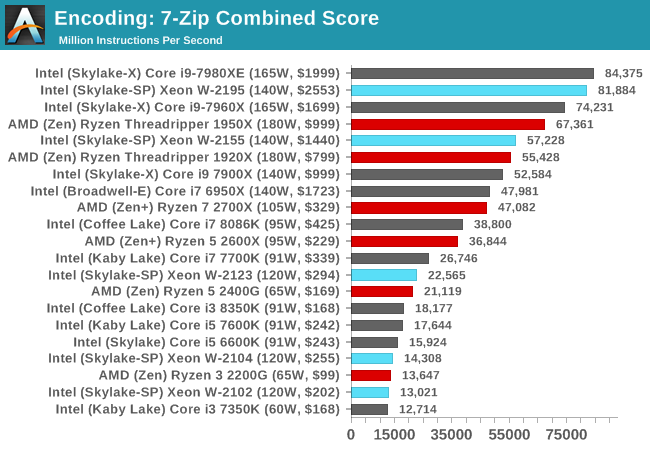

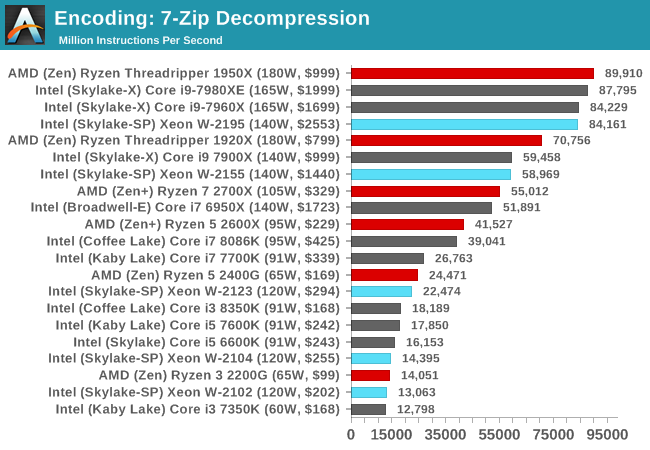
AMD's prowess in decompression means that it takes the top spot, however overall the W-2195 and the i9-7980XE are competing for top spot.
WinRAR 5.40
For the 2017 test suite, we move to the latest version of WinRAR in our compression test. WinRAR in some quarters is more user friendly that 7-Zip, hence its inclusion. Rather than use a benchmark mode as we did with 7-Zip, here we take a set of files representative of a generic stack (33 video files in 1.37 GB, 2834 smaller website files in 370 folders in 150 MB) of compressible and incompressible formats. The results shown are the time taken to encode the file. Due to DRAM caching, we run the test 10 times and take the average of the last five runs when the benchmark is in a steady state.
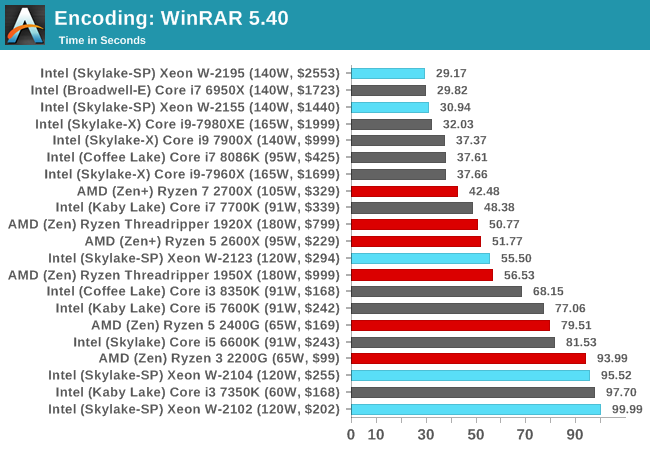
WinRAR likes cores and memory, and it seems that even the W-2155 can win against the Core i9-7980XE in this test. Despite the quad channel memory for the Xeon W quad core parts, the low frequency means they are bringing up the rear. The W-2123 hits mid-pack, actually beating the Threadripper 1950X in this test.
AES Encoding
Algorithms using AES coding have spread far and wide as a ubiquitous tool for encryption. Again, this is another CPU limited test, and modern CPUs have special AES pathways to accelerate their performance. We often see scaling in both frequency and cores with this benchmark. We use the latest version of TrueCrypt and run its benchmark mode over 1GB of in-DRAM data. Results shown are the GB/s average of encryption and decryption.

HandBrake v1.0.2 H264 and HEVC: link
As mentioned above, video transcoding (both encode and decode) is a hot topic in performance metrics as more and more content is being created. First consideration is the standard in which the video is encoded, which can be lossless or lossy, trade performance for file-size, trade quality for file-size, or all of the above can increase encoding rates to help accelerate decoding rates. Alongside Google's favorite codec, VP9, there are two others that are taking hold: H264, the older codec, is practically everywhere and is designed to be optimized for 1080p video, and HEVC (or H265) that is aimed to provide the same quality as H264 but at a lower file-size (or better quality for the same size). HEVC is important as 4K is streamed over the air, meaning less bits need to be transferred for the same quality content.
Handbrake is a favored tool for transcoding, and so our test regime takes care of three areas.
Low Quality/Resolution H264: Here we transcode a 640x266 H264 rip of a 2 hour film, and change the encoding from Main profile to High profile, using the very-fast preset.
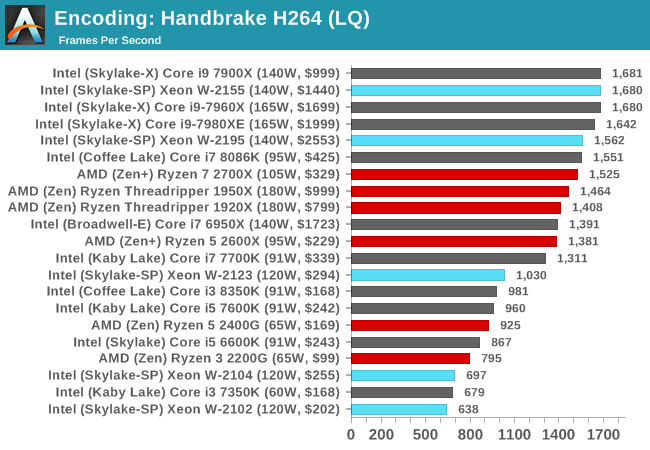
High Quality/Resolution H264: A similar test, but this time we take a ten-minute double 4K (3840x4320) file running at 60 Hz and transcode from Main to High, using the very-fast preset.
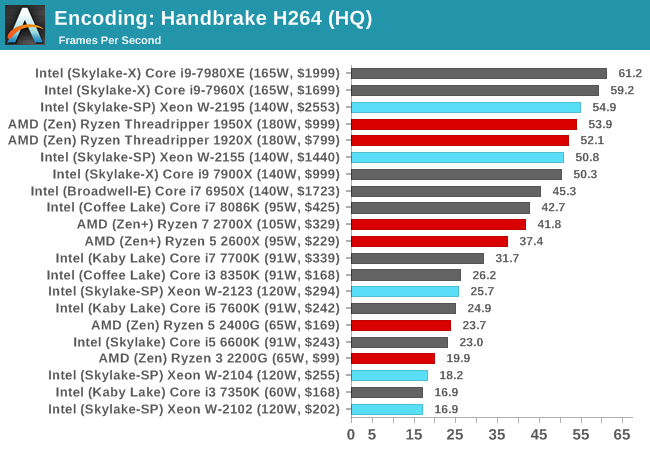
HEVC Test: Using the same video in HQ, we change the resolution and codec of the original video from 4K60 in H264 into 4K60 HEVC.
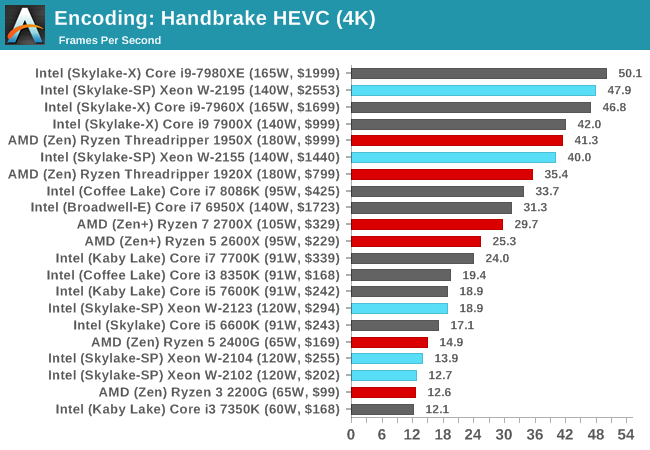










74 Comments
View All Comments
Ian Cutress - Monday, July 30, 2018 - link
If we ever get a Xeon Scalable system up and running for proper benchmarking, I'll run through some tests.JoJ - Saturday, August 4, 2018 - link
Hi Ian,I beg you to consider the futility of approaching HPE, to obtain a Z station and 56 Scalable cores, max RAM etc, may not may be wholly as anticipated.
I have a very high profile media production job coming, that could warrant a room of fully loaded such machines. Truly high profile. I have been always able to establish nearly immediate rapport with the marketing folk who are not apparently thought about by the UK online tech media, as warmly as I think it fair, but then I deal in printed worlds of very controlled readerships, and possibly by reflex alone I'm treated like I have more to say than I often do. But approaching the twenty five years mark, I probably ran out of lines some nineteen years ago anyway...
I care about hurling around heavily laden InDesign files, often without any media placeholders to include 409MB Hassleblad captures straight from the photographer. This project is going to be filled with custom adverts not run in any other media ever. (It took longer to agree copy for Rolls Royce than to sell the deal, in our first encounter with this project. VWAG owned both marques including Bentley, then.) Advertisers may visit, our job to produce for them their first display copy ever, because of interest from services who are in the word of mouth referral ecosystem this publication represents. We are effectively building a advertising studio, to accommodate the needs presented by, eg a long established security company, beyond public profile not by necessity or plan but rather not seeing the circle squared to deliver satisfactory result, without establishing unwanted capacity or staffing. So founder directors shall descend, for interview and portrait, the deal being approved by them signing a proof of the pages, in person, ideally we are able to complete 60% of the interview and layout remotely in advance.
I want to suggest to you that HPE could genuinely be intrigued by the client base of our project, and want to be exposed to them... mostly boutique banks and funds. A typical user is running a dozen Bloomberg Professional windows, Excel, with live updates and a lot of libraries for giving cell results, will have a terabyte or so of core textual references, between academic papers, email threads, online discussion (usually scraped) , and the job is to fill very specialist magazines with content and advertisers who don't play in the spray and pray brand game, but care everything about how they're found by a prospective new customer. So atop the trappings of a financial trader's desktop, will be layered Word, sure, but a TeX compositor, Visual studio, InDesign, PS...WHY? Because if we can get the message right, we can trade quickly to fill a matching campaign of the same redundancy as big ad buyers get, at even sharper prices. They come for creative, stay for flow execution.
It's realistic, even commonplace, for a Xeon Scalable workstation to find itself in front of board member powers, in this way.
Looking at the decisive commitment required to purchase current generation high end workstations, I assume that HPE, Dell et.al. just lean on their direct sales forces.
but strip away our Corporate veneer, and we're indistinguishable from any of your readers.
Individual buyers of workstation class computers, commonly inhabit the front line trenches of high end media production. London seethes with freelancer artists, driven by insufficient investment by employers, to fly solo simply to stay current with the tools and turnaround of their art. I can't win any argument about how far from the public imagination of the game, is the typical MB Pro user, sat elegantly in a WeWork chair, I thought my first sight of the Barbican WeWork office, was a film set... (whereas we're actually building a film set where to conduct our FOH business, because I can't vouch for the appearance of our actual digs. (Mr CIO left of his own accord, incapable of tolerating our disinterested views of fancy workspaces... the fact that our dev team is 80% founder level partner, actually never came into play, but the non attendance at his"corporate development" meetings, was protest against the idea of competing for hires with luxuries. Pity, in this one respect alone, the one character aspect we didn't believe necessary to investigate in interview, so patent is our third world architectural infrastructure, relations truly soured only because the guy was so good in every way otherwise. We just couldn't please with such capital commitments, not looking at the impending A grade glut just completing in the City. Such dangerous words; "absolutely, in the future, if you take us there, we will want a statement head office for sales etc". Just not on any immediate plans..
sorry, Ian, I am avoiding saying that I think I certainly could sell a HPE on the facts we know very well, where they'll be getting sales, in this sector at least, more from physical exposure to buyers and influencers, directly demonstrated the new generation capability by entirely non conveniently situated independent professionals and outside service companies, but absolutely nothing to look at in the kind of performance review I can't really understand is so homogeneous online, because this sort of evaluation hardly relates to the real use at all.
I am adamant that the entire presentation of high end desktop bixes is hostile and increasingly damaging to sales of performance workstations to corporate office buyers of all kinds.
Wall to wall gamer imagery has diluted the public perception of utilitarian power of computers beyond homeopathic insignificance.
Nothing, not a single word for twenty years- it seems to me - has conveyed any part of this crucial message: "With this new Intel computer, and the latest developments in the most advanced quantitative tools for generations, I WHOOP MY COMPETITIONS REAR!'
By all means, running a renderer matters in the industry that we inhabit. But the reason why we'll shell out for a 56 core beast, is so we can quickly previs a scene, while still working through the latest circulation data dump for the 200,000 or so publications we trade advertising on. Most days, we're rendering visuals of the data we don't want to take our concentration aeay from, again the reason why we're looking at the new HPE Z station Scalable workstations.
i have to be distracted but I'll conclude with guaranteed brevity upon my short return. There's plenty of angles here to get a vendor to cough up a couple of fully loaded machines for you, and I am entirely serious I'll invest the necessary time to get you a shot if you think I'm not batshii crazy. bfn
Elstar - Monday, July 30, 2018 - link
To be fair, the top end Core X and Xeon W have different TDP values.HStewart - Monday, July 30, 2018 - link
So does TDP values make bigger impact than actual Frequency - on same chip of course.BurntMyBacon - Tuesday, July 31, 2018 - link
It is more that TDP and frequency can no longer be separated. If you completely ignore TDP and fix the frequencies to their maximum, then TDP only matters in as much as you have the proper cooling solution to manage it. However, the actual running frequency of Intel's processors are tied into processor temperature, power, number of active cores, etc. On the same chip, a larger TDP means the processor can spend more time at higher frequencies or have more cores active at the same frequency.mode_13h - Monday, July 30, 2018 - link
The difference relative to X-series is probably due to thermal throttling due to dual AVX-512 and heat buildup under the non-soldered IHS.HStewart - Monday, July 30, 2018 - link
That would also be interesting test - I believe AVX-512 can be turned off in bios - not sure since I don't have one.JlHADJOE - Tuesday, July 31, 2018 - link
Lack of Turbo Boost 3.0 maybe?stanleyipkiss - Monday, July 30, 2018 - link
Besides the VM situation on Threadripper, why would anyone spend $2500+ for this?duploxxx - Monday, July 30, 2018 - link
what VM situation?